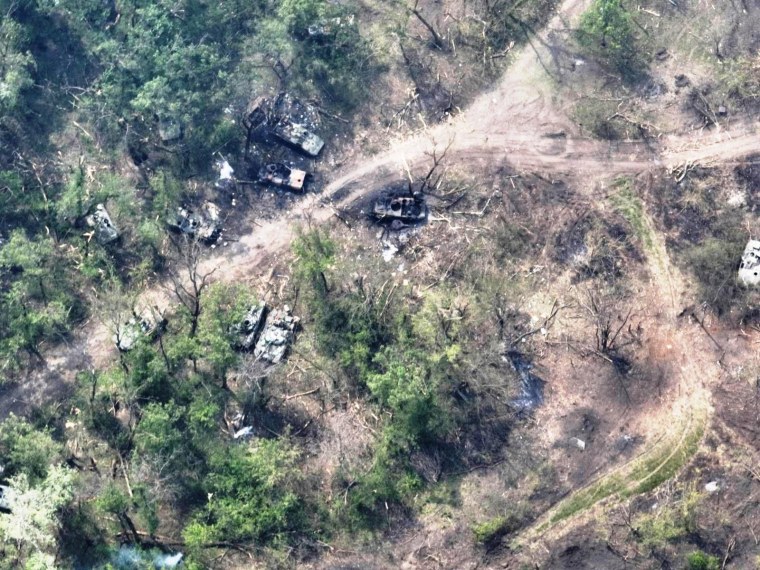Ukraine’s military says it blew up a key Russian crossing on the Siverskyi Donets River on its eastern front, inflicting heavy losses in a potentially significant blow to the Kremlin’s designs on the regions of Luhansk and Kharkiv.
Images shared by the defense ministry appeared to show a ruined pontoon crossing with dozens of destroyed or damaged armored vehicles on both banks.
“Artillerymen of the 17th tank brigade of the #UAarmy have opened the holiday season for [Russian forces],” the ministry said on Twitter. “Some bathed in the Siverskyi Donets River, and some were burned by the May sun.”
May 11, 202201:55
Kyiv’s strategic communications directorate tweeted images of smoking wreckage and two ruined bridgeheads, and said that the army’s 80th Separate Assault Brigade had “destroyed all attempts by the Russian occupiers to cross” the river.
The Siverskyi Donets, which flows from southern Russia through the separatist Ukrainian regions of Kharkiv and Luhansk, has become a key barrier against Russia’s attempts to shore up the territory it has seized since invading in February.
 Images released by Ukrainian armed forces appear to show Russian tanks destroyed along a dirt track by the river. Ukrainian Armed Forces
Images released by Ukrainian armed forces appear to show Russian tanks destroyed along a dirt track by the river. Ukrainian Armed Forces
Ukraine’s military on Wednesday said that Russian forces had been trying to gain full control over Rubizhne, a city of 55,000 people on the eastern bank of the river, and were conducting an offensive on Lyman, some 50 kilometers (about 31 miles) further west.
“[The] Russian enemy is trying to hold positions on the right bank of the Siversky Donets River,” it said.
Britain’s defense ministry said Thursday that despite early successes in Kharkiv, Russia had in recent days begun moving units to the eastern flank of the Siverskyi Donets in order to “reorganize and replenish its forces following heavy losses.”
In April, Ukraine blew up a bridge in the neighboring Kharkiv region in an attempt to stop Russian advances.
“Russia has been working on the encirclement of Ukrainian forces,” said William Alberque, director of strategy, technology and arms control at the International Institute for Strategic Studies, which is based in London.
“The Ukrainians blew a couple of critical bridges to prevent this. The Russians then created this pontoon bridge, creating a bottleneck with lots of equipment.”
He said the details in the images of the site — which showed severe but concentrated damage — suggested a highly accurate use of heavy artillery guided by drones or nearby ground forces.
Serhiy Haidai, a Ukrainian military official in Luhansk, was quoted in local media as saying the pontoon attack took place on Russian units seeking to cross the river near the town of Bilohorivka and close to the Lysychansk-Bakhmut highway, a key Ukrainian supply route.
“Bilohorivka is now an outpost of Luhansk oblast where Ruscists keep trying to cross the river, but end up feeding the fish,” he said.
Alberque said that although Russia lost a number of armored personnel carriers in the attack, that was unlikely to change the course of the conflict in Kharkiv and Luhansk.
“I think this will significantly affect operations in the region for a while, but it’s not as if Russia is short” of the carriers, he said.
The Siverskyi Donets pontoon attack may instead offer clues as to the tactics being deployed by both sides.
“Ukraine is using geography, they’re using rivers, anything they can to force the Russians into choke points, and then attacking those choke points when they become permissive targets,” Alberque said.
“To have this many vehicles in this small a space this close to the Ukrainians shows incredibly poor discipline from the Russians.”

